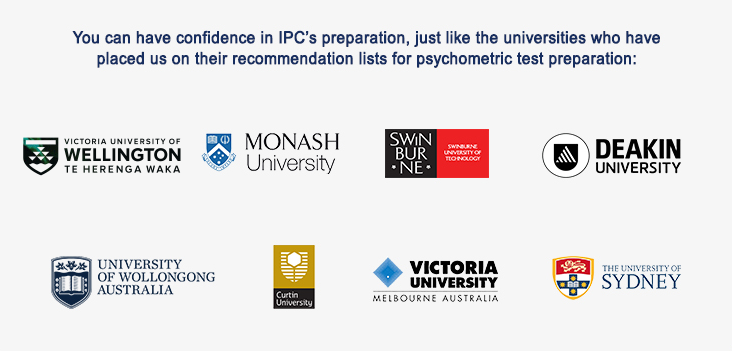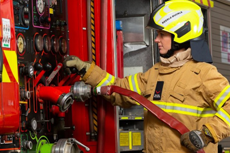Preparing for ACT Fire and Rescue's Aptitude tests - timed practice tests with real questions, detailed solutions, online courses & 1-on-1 tutoring
Preparation for ACT Fire & Rescue (ACTF&R) aptitude tests, group activity & Interview 2025
f you are applying to join ACT Fire and Rescue, you will be required as part of stage 2 of your recruitment process to take several challenging Psychometric tests managed by Hudson:
A timed special abstarct reasoning test .
A timed verbal reasoning test
A timed numerical reasoning test
A timed spatial reasoning test
What is ACT Fire and Rescue's abstract reasoning test?
As part of your selection with ACT fire and Rescue you will be asked to complete a timed abstract reasoning test, which which is very different from the type of shapes that you might be used to. The test takes around 20 minutes to complete.
ACT Fire and Rescue's abstract reasoning test timer:
ACT's fire and rescue absttract test is timed. The timer is set for each test question. You are given 90 seconds to complete each abstract test question.
ACT Fire and Rescue's abstract reasoning test questions style:
Let's check the following example abstract test question. In this free example aptitude test you need to find what specific buttons do to a group of shapes in the question line based on several example lines in the Base Screen box. Once you find what the buttons do your then can find what the correct final figure is in the question line. Let's examine the following abstract test example:

In this abstract test question you need to find what buttons 1, 3 and 5 do.
From the first line, we see that the original figure (the three shapes to the left) goes through two transformations to form the figure on the right: (i) a change in the shapes (square to circle, or circle to square); and (ii) a change in colours (black to white, or vice versa). Two buttons are active in this line (1 and 2); however, we still don’t know which one changes the shape, or which one changes the colour.
The second line also shows a figure that swaps the colour of its three shapes, but there is no change in those shapes. This time, buttons 2, 3 and 4 are ‘active’ – so, button 2 (the only common ‘active’ button with line 1) must be the one that swaps colours; and we can now deduce that it is button 1 that changes (or toggles) the shapes. Buttons 3 and 4 must, then, be the ones that modify the horizontal and vertical lines, so we will need to refer to the third line to work out their individual functions.
In line three, because buttons 1 and 2 are ‘inactive’, we know that there will be no transformation of colour or shape. Buttons 4 and 5 are ‘active’, and we can see that the right figure has been made smaller and a vertical line removed. Line 3 shares only one active button with line 2 (i.e. button 4), and there is only one common transformation between these lines: the vertical line has been switched ‘on’ or ‘off’. Therefore, button 4 is a vertical line toggle switch, which means (from the previous line) that button 3 must be the on/off toggle for horizontal lines. Button 5, therefore, can only be for changing (or toggling) the size of the shapes in the figure (from big to small, or vice versa).
We can now summarise the button functions thus:
- Button 1 – toggles the shapes within the figure (squares to circles, and vice versa)
- Button 3 – toggles the horizontal lines on or off
- Button 5 – toggles the size (big or small) of the shapes within the figure.
Now, we can apply those button functions to our question line:
- Button 1 – will change the figure to a circle and a square.
- Button 3 – will add a horizontal line to all shapes in the figure.
- Button 5 – will toggle the shape sizes – the first from big to small, and the second from small to big.
The correct answer is:

Remember: don't waste time practising abstract or inductive reasoning test questions styles that you will not have in your real abstract or inductive aptitude test.
What is ACT Fire and Rescue's verbal reasoning test?
ACT Fire and Rescue's verbal reasoning test measures your ability to understand verbal information, think logically about written information, accurately draw logical conclusions, produce written reports, and convey information to others in a clear and simple manner.
ACT Fire and Rescue's verbal reasoning test timer
ACT's verbal reasoning test is timed. The timer is set for each test question. You are given 90 seconds to complete each verbal test question.
ACT Fire and Rescue's verbal reasoning test questions style
The verbal test questions include paragraphs of information, following by statements and questions relating to the paragraph. Your task is to accurately answer each question or statement based on the information provided in the paragraphs.
Let's review the following ACT Fire and Rescue verbal aptitude example question:
Read the following passage and answer the question:
In epistemology, the Munchausen trilemma is a thought experiment used to demonstrate the impossibility of proving any truth, even in the fields of logic and mathematics. If it is asked how any knowledge is known to be true, proof may be provided. Yet that same question can be asked of the proof, and any subsequent proof. The Munchausen trilemma is that there are only three options when providing proof in this situation: (a) the circular argument, in which theory and proof support each other; (b) the regressive argument, in which each proof requires a further proof, ad infinitum; and (c) the axiomatic argument, which rests on accepted precepts. The trilemma, then, is the decision among the three equally unsatisfying options.
The name Munchausen Trilemma was coined in 1968 by the German philosopher Hans Albert in reference to a trilemma of “dogmatism versus infinite regress versus psychologism” used by Karl Popper. It is a reference to the problem of ‘bootstrapping’, based on the story of Baron Munchausen pulling himself and the horse on which he was sitting out of a mire by his own hair.
Which one of the following does NOT follow based on the content of the text?
a. Karl Popper was a German philosopher.
b. There are three argument options when providing proof of whether any knowledge is true.
c. The axiomatic argument is one which rests on accepted precepts.
d. When each proof requires further proof ad infinitum, it is called a regressive argument.
e. Baron Munchausen rode a horse.
To answer this style of test questions you need to read the passage to find the correct answer. Nowhere in the text does it mention Karl Popper’s origins. The text only says that Hans Albert was a German philosopher. Therefore, the correct answer is that Karl Popper was a german philosopher.
What is ACT Fire and Rescue's numerical reasoning test?
ACT Fire and Rescue's numerical test measures your numerical reasoning skills. The test doesn’t measure your skills in maths but your ability to quickly and logically process numerical information.
The numerical reasoning test timer:
ACT Fire and Rescue's numerical reasoning test is timed. The timer is set for each test question. You are given 75 seconds to complete each numerical test question.
The numerical reasoning test questions style
ACT Fire and Rescue's numerical includes sets of 4 questions. Each set has unique background information and 4 test questions. The test is designed so you will have almost no time to complete answering all sets. Your task is to quickly select the correct answer for each test question based solely on the information presented.
Example Hudson numerical reasoning test question

What is the ratio of the differences in actual sales to target sales in Thailand and Italy during the fourth quarter?
a. 2:1
b. 3:4
c: 1:2
d: 4:3
e. 3:2
f. 2:3
To answer this test question, we need to review the information provided in the table. According to the table, Thailand’s fourth-quarter sales target was 550, but actual sales were: 205 + 105 + 260 = 570. This is a difference of 20 (570 – 550). Italy’s target was 600 sales, but actual sales were: 125 + 250 + 240 = 615. The difference here was 15 (615 – 600). Therefore, the Thailand to Italy ratio of differences is 20:15 = 4:3.
ACT Fire & Rescue group activity
What is measured in a group activity?
- Your ability to influence others.
- Your level of involvement in performing a group task.
- Your communication style - are you kind, aggressive, dominant, controlling, accommodating, listening when interacting with others?
- The quality of your contribution to the team.
How are you measured in a group activity?
Your individual and others style of interaction during the entire group activity are observed and assessed by qualified observers who are typically psychologists or people with special qualifications.
The group activity is used as an opportunity to measure your ability to work and interact with others such as your communication skills, listening skills, influencing skills, negotiating skills, social confidence, ability to encourage others, decision making skills.
The actual group activity has little importance to the measurement of your skills. It is merely used as a background or a trigger to create a group interaction between you and other participants.
What are good qualities to demonstrate in a group activity?
If you are capable of influencing others in a group activity, show capability to listen to others, contribute to the group effort and offer constructive ideas you are likely to be tagged as a suitable candidate for managerial roles.
If you demonstrate good social skills, you are considerate but you are lacking decisiveness and ability to influence others then you are likely to be tagged as a less suitable candidate for a managerial role but might be suitable for positions that require team work or cooperation with others and less managerial substance.
If you demonstrate a dominant behaviour by taking control over the activity, you don’t listen to others, you don’t encourage others’ contribution and are less considerate to others then you are less likely to be suitable for a position that requires team work.
Is the quality of the group outcome important?
One of the common mistakes is to assume that an assessment centre measures the team’s behaviour and outcome. In other words, has the team achieved its goals or objectives. However, the observation is not focused on the outcome. It is only focused on measuring your behaviour in the team. The atmosphere in the team and the quality of its outcome have no impact in a group assessment.
What are the challenges of a group activity?
An unknown group activity and the need to manage group dynamics are factors that often lead participants to an excessive sense of stress. This type of test is especially more difficult and challenging for people who are more introverted and less socially confident.
Most of us need some time to adjust and feel comfortable and confident in a new situation and new people. Some of us need more time to get comfortable and others need less. However, a group activity exercise offers us no time to adjust but requires you to respond immediately to a problem which is presented to the group members. People’s response to such a situation can be very different:
- Some become quiet and close up.
- Some become aggressive and dominant.
- Some feel very comfortable almost like a fish in the water.
Becoming quiet and closed up
This style of negative communication in a group activity is typically characterised by the following behaviours:
- Sitting quietly through the activity, as you feel scared to take part.
- Sitting and watching others take control.
- Rarely (if the group is fairly quiet) trying to express your view but this is done in a low and hesitant voice so it gets little attention from the group.
Aggressive and dominant behaviour
This style of negative communication in a group activity is typically characterised by the following behaviours:
- Over need to take control over group activity.
- Excessive involvement and need to influence every decision.
- A tendency to dictate to others what to do.
- A lack of interest to listen to others or encourage others to express their opinion.
Feeling socially comfortable
This positive style of communication in a group activity is typically characterised by the following behaviours:
- An interest to listen to others’ opinions.
- An ability to persuade others in a kind and friendly way.
- A friendly demeanour when interacting with others such as smiling, approaching people by their names and showing positiveness.
Our Professional Preparations for your aptitude tests, group activity & Interview with ACT Fire & Rescue:
The Institute of Psychometric Coaching has developed a variety of tailored preparations to ensure you are ready for your tests with ACT Fire and Rescue.
Our professional preparations include:
1. Practice aptitude tests online customised for ACT Fire & Rescue:
- A large pool of timed practice aptitude tests with timers and detailed answer explanations.
- Based on similar Hudson's test questions.
- Timer mimics the pressure of taking the real test.
- Step by step solutions at the end of each aptitude test.
- Test scores in comparison to others.
- Feedback on how to improve.
- Immediate Access.
2. Aptitude test courses online for ACT Fire & Rescue:
- Special aptitude tests' courses online with all the knowledge you need to pass ACT Fire & Rescue's tests.
- Abstract Test Course online with some example test questions.
- Verbal Test Course online with some example test questions.
- Numerical Test Course with some example test questions.
- Immediate Access.
3. 1-on-1 coaching for your aptitude tests, group activity and behavioural interview with ACT Fire & Rescue:
- Delivered by expert Psychometricians who are experienced with ACT fire and rescue aptitude tests.
- Face to face or via Skype live.
- Includes special material, techniques and guidance how to solve ACT Fire & Rescue aptitude test questions.
- Applying with you the techniques and guidelines to example aptitude test questions for ACT fire & Rescue to ensure that you know how to solve these questions.
- Working with you how to shine in the group activity. including simulations and real feedback.
- Working with you to ensure you demonstrate your full potential and capabilities in ACT Fire & Rescue's group activity and behavioural interview.
- Working with you to prepare you for the behavioural questions for ACT fire & rescue's interview.
- Special simulations and real time feedback for your interview.










